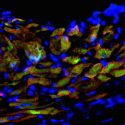Genetic approaches to cancer, neural development lead to honor for UW-Madison scientists
Two University of Wisconsin–Madison researchers — one investigating the genetic basis of cancer growth and the other, the role of genes in neural development and learning — have earned funding and a prestigious honor from the Greater Milwaukee Foundation.
Peter Lewis, assistant professor of biomolecular chemistry, and Marc Wolman, assistant professor of zoology, have each received a $200,000 grant through the Foundation’s competitive Shaw Scientist Program. The annual award supports emerging investigators with innovative ideas in biochemistry, biological sciences and cancer research. Since the dollars are unrestricted, researchers can use their Shaw Scientist Award to develop preliminary data essential in competing for federal research funding.
“For more than three decades, the Shaw Scientist Program has rewarded the innovation of young investigators by providing valuable seed funding for their work,” says Ellen M. Gilligan, president and CEO of the Greater Milwaukee Foundation. “Developing better treatments for disease takes an investment in promising research, and private philanthropic support can help move these projects out of the starting gate.”
Lewis studies how changes in the chemical composition of DNA and the proteins that package the human genome (together known as chromatin) influence whether particular genes are activated or silenced in a given type of cell. His current work relates to childhood cancers. Recent studies have shown that many pediatric cancers likely stem from mutations that cause a change in chromatin structure.
“The improper activation or silencing of genes can promote tumor formation by altering the normal pathways that keep cells from proliferating uncontrollably, a common feature of cancer cells,” Lewis says. “In addition to advancing current diagnostics, our present work will also identify new molecular targets for future therapeutic intervention of these devastating malignancies.”
Securing federal funding for promising new ideas can be challenging, because there is less data to demonstrate the merit of a novel design. The Shaw Scientist Award provides the means to pursue an experimental approach, Lewis says.
Lewis earned a bachelor of science from University of Virginia and a Ph.D. from University of California-Berkeley. His post-doctoral training was completed at The Rockefeller University.
Wolman seeks to understand how genes function to allow the brain to learn. His team recently identified a set of genes used by the brain to encode for a simple form of learning called habituation and noted that any disruption in the function of these genes leads to learning impairment. With his Shaw Scientist Award, Wolman plans to explore how one of these genes affects neuronal connections to promote learning. The information could have implications for treating various nervous system disorders, including schizophrenia and dementia.
“The Shaw Award carries tremendous value to a young investigator, particularly when federal funding is so limited,” Wolman says. “The award provides an opportunity to probe deeper into the unknowns of how the learning genes we identified actually influence the brain.”
Wolman received both his bachelor of science and his Ph.D. from UW–Madison. He completed post-doctoral studies at Perelman School of Medicine at University of Pennsylvania.
The Shaw Scientist Award program started in 1982 thanks to a $4.3 million bequest from Dorothy Shaw, widow of James Shaw, a prominent Milwaukee attorney. In addition to $2 million in special grants, Shaw’s fund has awarded nearly $13 million in grants to 69 scientists from UW–Madison and University of Wisconsin-Milwaukee over the past three decades. An advisory panel with scientists representing major U.S. research institutions recommends the winners.
For a century, the Greater Milwaukee Foundation has helped individuals, families and organizations realize their philanthropic goals and make a difference in the community, during their lifetimes and for future generations. The foundation consists of more than 1,200 individual charitable funds, each created by donors to serve the charitable causes of their choice. The foundation also deploys both human and financial resources to address the most critical needs of the community and ensure the vitality of the region. Established in 1915, the foundation was one of the first community foundations in the world. With total assets of more than $847 million, it is also among the largest.
###
Tags: health & medicine, research



